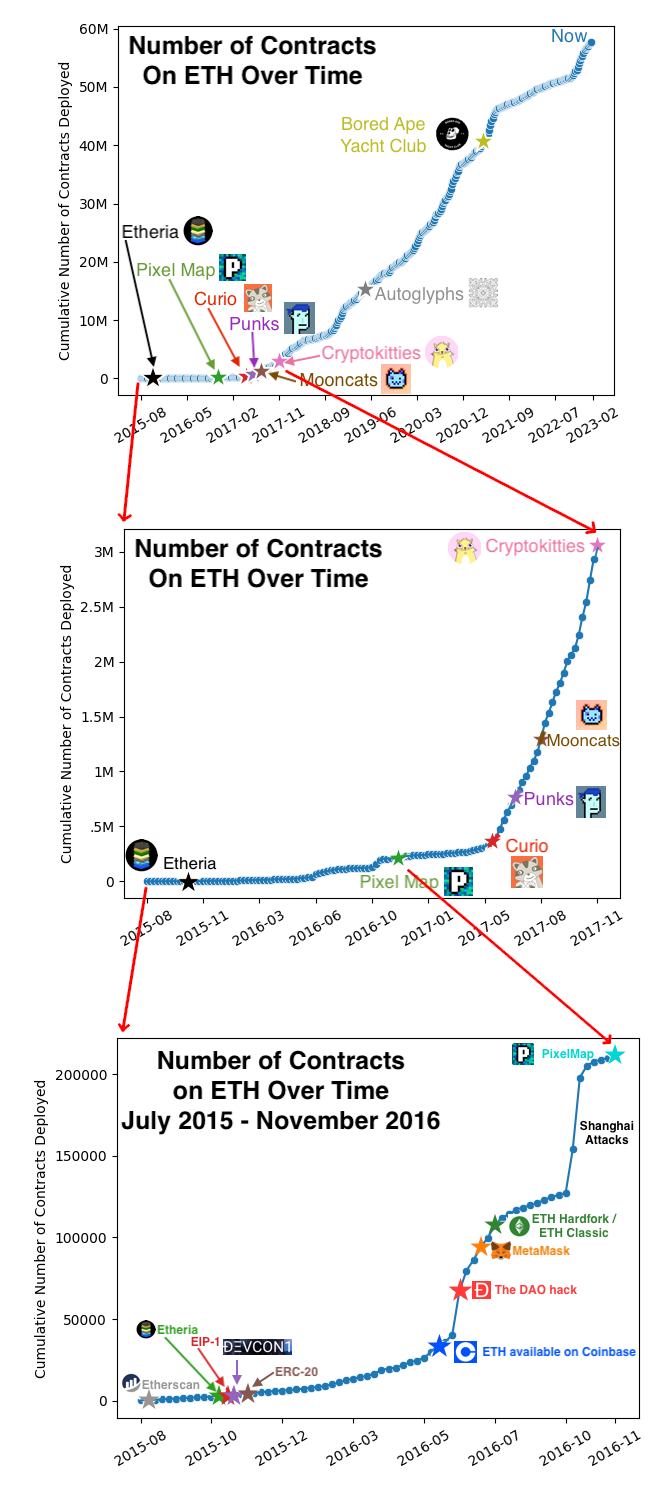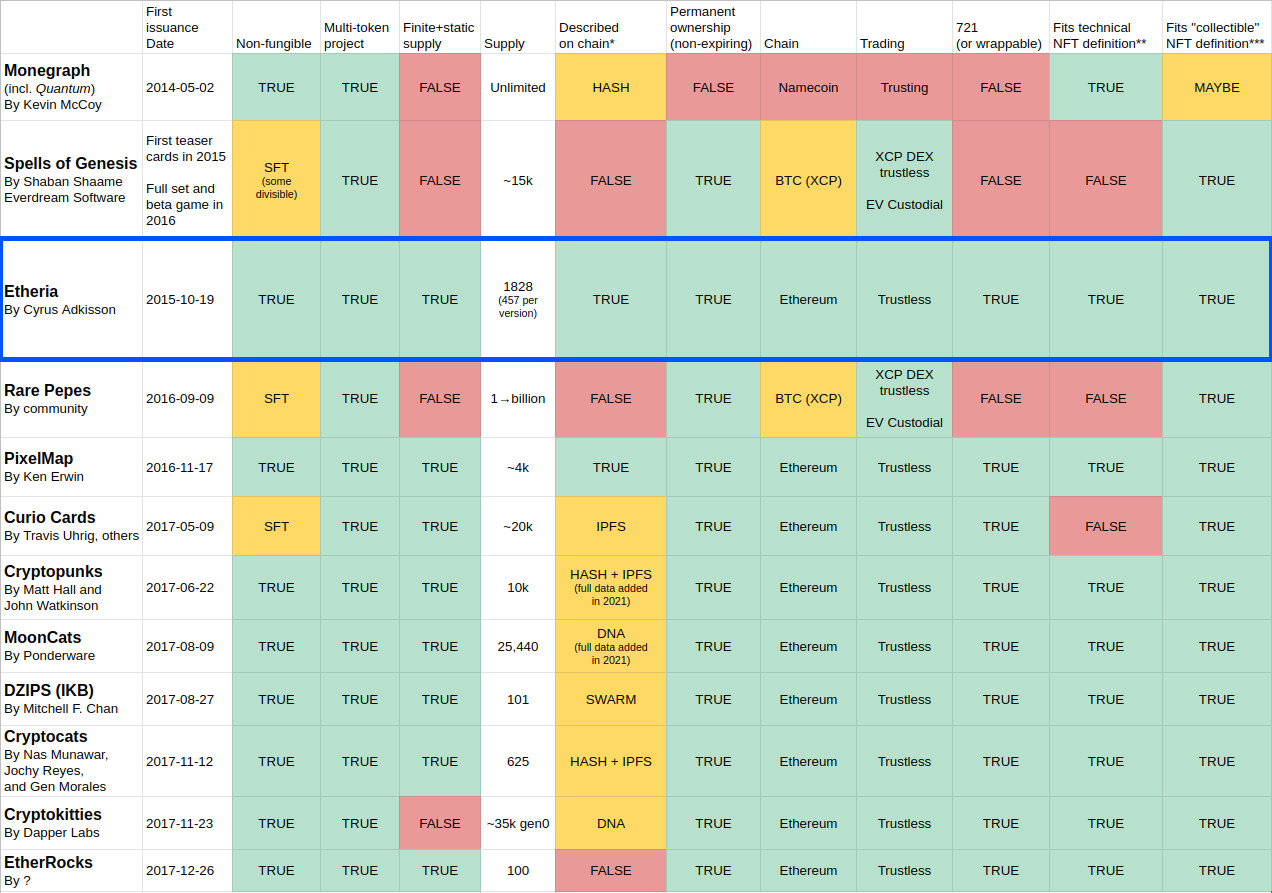Last update: Jan 18, 2024
- All other Ethereum cryptocollectible and NFT projects including Cryptopunks, Cryptokitties, Curio Cards, Pixelmap, etc
- RarePepes (birth of tokenized external "cryptoart", 2016)
- Spells of Genesis (game 2016, promo cards 2015 on Counterparty)
- Metamask (2016)
- The DAO hack & Ethereum Classic (2016)
- Stablecoins (2017, hence the original hardcoded price of 1 ETH per tile)
- ETH reaching $1 ($0.43 cents at time of deployment)
- Opensea (2017)
- ERC-20 proposal (Nov 2015)
- ERC-20 (2016)
- ERC-721 (2017)
- Decentraland (2017)
- Coinbase offering ETH for sale (2016)
- EIP-1
Unwrapped (any version) → NO! You will lose your tile.
That story is best told through this video or this Twitter thread. More info:
In March 2021, shortly after Etheria's rediscovery, I (Cyrus) bought up all the remaining tiles in two earlier versions of Etheria I found in my deployment history due to concerns about their trading safety. These earlier base contracts feature internal trade logic which, in both versions, is awkward and impractical and, especially in v0.9, unsafe to use unless great care is taken to prevent front-running.
After a year of heads-down development on v1.2 (exchanges, world rendering, etc), I finally realized a few things about these 2 earlier contracts:
- They're wrappable, modernizable for OpenSea, etc
- Once wrapped, the old trade logic is entirely bypassed and irrelevant (i.e. trading is made safe)
Knowing the above and for a number of reasons, in March 2022, I made the decision to wrap and airdrop these versions to the "official" holders of v1.2 and create a 4-map Etheria Multiverse consisting of:
- v0.9, the first viable, fully-decentralized NFT smart contract ever (2015-10-19)
- v1.0, the first official release of Etheria, announced on Reddit (2015-10-22)
- v1.1, the second official release of Etheria, announced on blog (2015-10-29)
- v1.2, the "final" official release of Etheria, presented at Devcon 1 (2015-11-01)
Use the wrapping page to wrap unwrapped v1.0- tiles.
v0.9 is the first viable version of Etheria, according to my extensive research into my own blockchain history. I deployed some earlier test versions of Etheria but they were either killable (and I killed them) or developmentally incomplete in such a way that the tiles were either non-transferrable (worthless) or always stealable (also worthless). Hence v0.9 as "first viable". And it's wrappable via normal methods.
v1.0 is the first official release interacted with by people other than myself. I announced it on reddit. This version is also wrappable via normal methods.
v1.1 is the second official release which I noted in my blog at the time and on the official website, but did not otherwise announce. This is the first version to use a simple setOwner (which was smart) but also used tx.origin (which was dumb). The latter means this version is not wrappable by normal methods, though it may ultimately prove wrappable by non-traditional methods. We're working through that now and have been unable to knock down our current working theory (which is positive). All v1.0 tile ownership was mirrored onto v1.1 immediately after deployment and then the contract was locked.
v1.2 is the final official release which I presented at Devcon 1 in 2015 and which saw significant interaction from the small community at the time, though even this version didn't sell out back then. It contains the first real on-chain artworks in the cabin, the horse, the colosseum, etc. Same wrappability notes as v1.1. All v1.1 tile ownership was mirrored onto v1.2 immediately after deployment and then the contract was locked.
"Minting" is a relatively new concept in NFTs. When a person "mints" an NFT, the blockchain space and information about that NFT are reserved and written at that time.
For example, as BAYC began to mint in 2021, there were no Bored Apes at all - no blockchain space dedicated to them whatsoever. Then, one-by-one, as they were minted, the blockchain space and links to the external art were created as people clicked the "mint" button.
Etheria's 1089 tiles (457 purchasable land) (per version), on the other hand, all came into existence at the same time in 2015. Each tile was initialized with a column, row, elevation, empty "name", empty "status" and the owner was set to "0x0000....0000".
As people bought the tiles in 2015, 2016, 2017 and finally 2021, no new blockchain space was created. The owner of the tile was simply set to the address of the new owner like this: 0x0000...0000 → 0xabc1...2345






